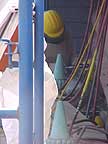It has been over a year since work on the
City Hall Exterior was begun. The East side of the courtyard has been completed.
The scaffolding has been relocated to the west courtyard, the east exterior,
and the east end of the north exterior. The tower has also been scaffolded
up to the clock level and work is nearing completion from the clock (level
17) down to level 12. The clock hands and drive shaft have been examined,
lubricated and repaired as necessary. The project is currently on schedule
and remains within the estimated budget.
Below are some thumbnail photos of the ongoing work. Click on any photo
for a full size picture. |
|
|
 The
minute hand on the east clock face was removed for shop repair when several
creases were found in the hollow arm which was formed out of copper. The
hand is 15 ft long from its tip to the end of its counter weight. The
minute hand on the east clock face was removed for shop repair when several
creases were found in the hollow arm which was formed out of copper. The
hand is 15 ft long from its tip to the end of its counter weight. |

The South clock face prior to the erection of two additional levels
of scaffold required to access and inspect the hands. |
 Lowering
the damaged east minute hand to the ground. It was folded at the existing
creases for ease of handling. It did Lowering
the damaged east minute hand to the ground. It was folded at the existing
creases for ease of handling. It did
not look like this when it was removed! |
 Several
masonry pieces were severely cracked and spalled. These were cut out and
new dutchmen are inserted and pinned in place. Several
masonry pieces were severely cracked and spalled. These were cut out and
new dutchmen are inserted and pinned in place. |

A statue on the north face of the tower had lost a knee. A new knee
was sculpted and a repair similiar to a dutchman was made. |
 Several
areas on the tower were coated with carbon deposits. These areas were cleaned
by misting with fine jets of water for up to 24 hours. This method of cleaning
is less harsh then the Jos method used on the bulk of the masonry. Several
areas on the tower were coated with carbon deposits. These areas were cleaned
by misting with fine jets of water for up to 24 hours. This method of cleaning
is less harsh then the Jos method used on the bulk of the masonry. |
 A
gutter was discovered at the base of the metal portion of the tower. It
had been overlooked in the 1989 renovation work and was so badly corroded
pieces might have fallen at any time. It was relined with copper pan and
refaced with lead-coated copper. A
gutter was discovered at the base of the metal portion of the tower. It
had been overlooked in the 1989 renovation work and was so badly corroded
pieces might have fallen at any time. It was relined with copper pan and
refaced with lead-coated copper. |

The gutter was in pretty poor condition when it was discovered. |
 The
Jos cleaning involves pressure spraying with water at about 30psi mixed
with a mild abrasive called dolomite. The difference in color of the stone
in this photo is not a shadow but a result of the cleaning process. The
Jos cleaning involves pressure spraying with water at about 30psi mixed
with a mild abrasive called dolomite. The difference in color of the stone
in this photo is not a shadow but a result of the cleaning process. |

All of the cast iron was painted with lead which required abatement
with a needle gun. Note the protective clothing worn by the workers. |

A closer view of the needle gun used for removal of lead paint. The
gun has a vaccum line that collects the lead for disposal in drums. |

All masonry joints in the stone were cut out in preparation for repointing. |
 After
removal of the lead paint, cast iron was removed & supports inspected.
Some pieces were taken to the factory for repair or refabrication. Many
pieces were repaired in the field.. After
removal of the lead paint, cast iron was removed & supports inspected.
Some pieces were taken to the factory for repair or refabrication. Many
pieces were repaired in the field.. |

Reinstalling some of the cast iron as it is returned from the factory |
 Some
masonry joints, especially those around statues & carvings, were cut
out by hand prior to repointing. Some
masonry joints, especially those around statues & carvings, were cut
out by hand prior to repointing. |